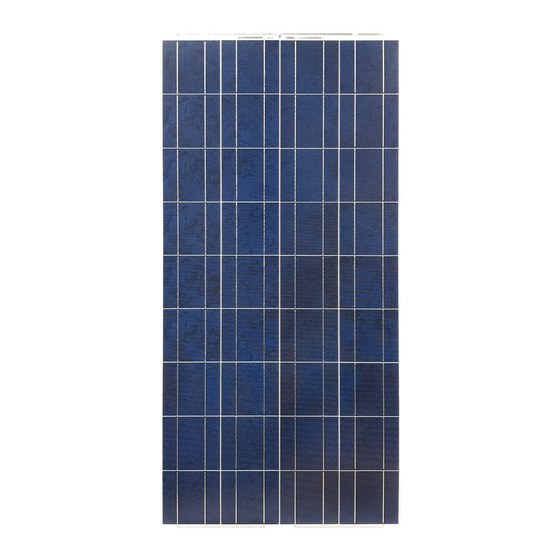
Advertisement
Quick Links
1. INTRODUCTION
As the world leader in development and application of high technology ceramic/silica materials, Kyocera Corporation
(KC) offers a wide range of highly efficient and reliable crystalline silicon solar photovoltaic (PV) power modules.
Kyocera began to extensively research PV technology in 1975 and commenced manufacturing operations in 1978.
Since then, Kyocera has supplied millions of cells and modules throughout the world. With years of experience and
state-of-the-art technology, Kyocera provides the highest quality PV power modules in a range of sizes designed to
meet the requirements of the most demanding energy and power users worldwide.
2. POWER MODULES
Kyocera power modules consist of a series of electrically interconnected crystalline silicon solar cells. Which are
permanently laminated within an ethylene-vinyl-acetate (EVA) pottant and encapsulated between a tempered glass
cover plate and a poly-vinyl-flouride (PVF) back sheet. The entire laminate is secured within an anodized aluminum
frame for structural strength, ease of installation, and to protect the cells from the most severe environmental
conditions.
3. APPLICATIONS
Kyocera modules are a reliable, virtually maintenance-free direct current (DC) power source, designed to operate most
efficiently in sunlight. Kyocera modules are ideal to power remote homes, recreational vehicles, water pumps,
telecommunication systems and many other applications either with or without the use of storage batteries.
4. WARNINGS
Solar modules generate electricity when exposed to light. Arrays of many modules can cause lethal shock and burn
hazards. Only authorized and trained personnel should have access to these modules. To reduce the risk of electrical
shock or burns, modules may be covered with an opaque material during installation to avoid shocks or burns. Do not
touch live terminals with bare hands. Use insulated tools for electrical connections.
PERMIT
・ Before installing your solar system, contact local authorities to determine the necessary permit, installation and
inspection requirements.
INSTALLATION AND OPERATION
・ Systems should be installed by qualified personnel only. The system involves electricity, and can be dangerous if
the personnel are not familiar with the appropriate safety procedures.
・ Do not step on the module.
・ Although KYOCERA modules are quite rugged, the glass can be broken (and the module will no longer work
properly) if it is dropped or hit by tools or other objects.
・ Sunlight shall not be concentrated on the module.
・ The module frame is made of anodized aluminum, and therefore corrosion can occur if the module is subject to a
salt water environment with contact to a rack of another type of metal.(Electrolysis Corrosion) If required,
stainless steel washers can be placed between the solar module frame and support structure to prevent this type of
INSTALLATION MANUAL
FOR THE
KC-SERIES
SOLAR PHOTOVOLTAIC POWER MODULES
Please read this manual carefully before installing the modules.
KYOCERA CORPORATION
OF
PVC or
Advertisement

Summary of Contents for Kyocera KC-120-1
-
Page 1: Power Modules
1. INTRODUCTION As the world leader in development and application of high technology ceramic/silica materials, Kyocera Corporation (KC) offers a wide range of highly efficient and reliable crystalline silicon solar photovoltaic (PV) power modules. Kyocera began to extensively research PV technology in 1975 and commenced manufacturing operations in 1978. Since then, Kyocera has supplied millions of cells and modules throughout the world. -
Page 2: Site Selection
corrosion. ・ The solar module frame must be attached to a support structure using ¼” or M6 stainless steel hardware in a minimum of four (4) places symmetrical on the solar module. The stainless steel hardware used for securing the module frame should secured with an applied torque of 6 foot-pounds (8 Newton-meters). -
Page 3: Module Wiring
As shown in Module Mounting Specifications, all of the KC modules utilize the Type G junction box except the KC-70, KC-80 and KC-120-1 modules which utilize the Type M junction box (see J-box details). This junction box, located on the back side of the module, is weatherproof and is designed to be used with standard wiring or conduit connections. - Page 4 C. The wire used to interconnect the solar modules may be single or two conductor, from 14 AWG (2.08 ) up to 10 AWG (5.26 mm copper wire, in a “SUNLIGHT RESISTANT” jacket UF cable. This cable is suitable for applications where wiring is exposed to the direct rays of the sun.
-
Page 5: Specifications
When a bypass diode is wired in parallel with the series string, the forced current will flow through the diode and bypass the shaded module, thereby minimizing module heating and array current losses. For 12-volt systems and higher: Each module junction box has a diagram illustrating the proper orientation of the bypass diode installed between two of the terminal screws (Figure 11, Figure 12). - Page 6 Length, Inches (mm) Width, Inches (mm) Depth (frame, Inches (mm) Depth (including j-box), inches (mm) Weight, Pounds (kg) Mounting Hole Diameter, inches (mm) * *Note: See Module Mounting Specifications for Hole Location on Frame KC-120-1 KC-80 KC-70 KC-60 21.5 21.5 21.5 21.5...
- Page 7 MODULE MOUNTING DIMENSIONS DO NOT USE DO NOT USE KYOCERA KC−SERIES MODULE MOUNTING SPECIFICATIONS...








